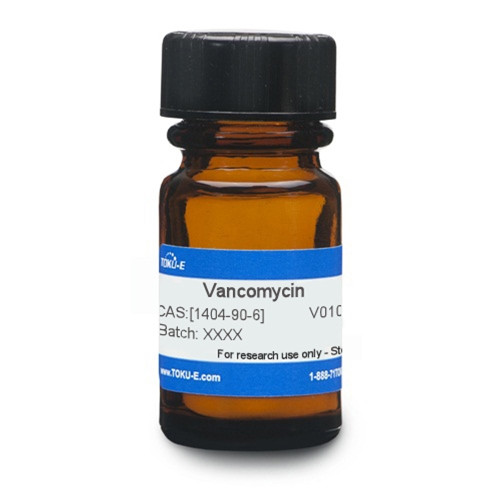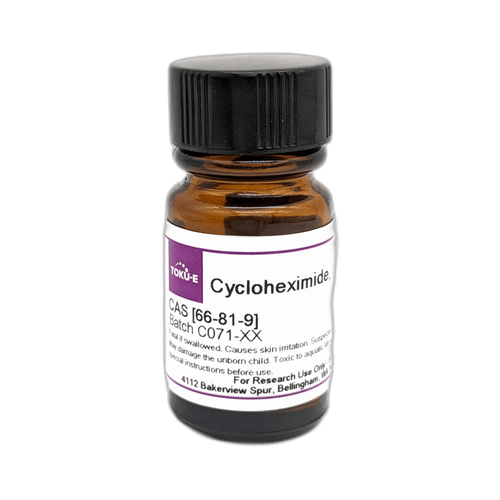Vancomycin Hydrochloride, CulturePure (Vancomycin HCl) is a glycopeptide antibiotic derived from Streptomyces orientalis that was discovered in 1953 from a soil sample found in Borneo. It is effective against Gram-positive bacteria such as Staphylococcus aureus, including MRSA. Vancomycin HCl is commonly used in selective media for isolation of Gram-negative bacteria as well as studies of nanoparticle transport and antibiotic resistance.
Vancomycin HCl acts as a bacterial cell wall synthesis inhibitor by preventing the transfer and addition of NAM/NAG-peptides that make up the peptidoglycan cell wall structure.
Vancomycin HCl, CulturePure has low cell toxicity to plant cells and has been used in combination with Cefotaxime or Carbenicillin to stop the growth of Agrobacterium in plant tissue culture and transformation studies.
We also offer:
- Vancomycin Hydrochloride, USP (V001)
- Vancomycin Hydrochloride, CulturePure (V007)
- Vancomycin ReadyMadeTM Solution (V040)
| Mechanism of Action | Vancomycin prevents peptidoglycan synthesis by two separate mechanisms. One mechanism prevents N-acetylmuramic acid (NAM) and N-acetylglucosamine (NAG) from linking together forming the peptidoglycan backbone. The second mechanism prevents crosslinking between amino acid residues in the peptidoglycan chain. |
| Spectrum | Vancomycin inhibits growth of many Gram-positive bacteria including the antibiotic resistant superbug, MRSA (Methicillin resistant Staphylococcus aureus). Vancomcyin is effective for treating MRSA infections because it inhibits cell wall synthesis through a different mechanism than β-lactam antibiotics. Gram-positive bacteria have emerged that are resistant to Vancomycin HCl, such as Vancomycin HCl resistant Staphylococcus aureus (VRSA) and Vancomycin HCl-resistant enterococci (VRE). |
| Microbiology Applications | Vancomycin HCl is commonly used in clinical in vitro microbiological antimicrobial susceptibility tests (panels, discs, and MIC strips) against Gram-positive microbial isolates. Medical microbiologists use AST results to recommend antibiotic treatment options for infected patients. Representative MIC values include:
Media SupplementsVancomycin can be used as a selective agent in several types of isolation media: Bolton Broth - Bolton Broth Selective Supplement Bolton Broth - Modified Bolton Broth Selective Supplement Brucella medium - Brucella selective supplement Brucella Medium Base - Modified Brucella Selective Supplement Campylobacter Agar - Campylobacter Selective Supplement (Karmali) Campylobacter Agar Base - Campylobacter Selective Supplement (Modified Karmali) Columbia Blood Agar - Campylobacter selective supplement (Skirrow) Columbia Blood Agar - Campylobacter selective supplement (Blaser-Wang) Columbia Blood Agar - Helicobacter pylori Selective Supplement (Dent) Legionella CYE Agar - Legionella GVPC Selective Supplement Legionella CYE Agar - Legionella MWY Selective Supplement Legionella CYE Agar - Legionella GVPN Selective Supplement mTSB - VCC Selective Supplement VRE Medium - VRE Selective Supplement Wilkins-Chalgren Anaerobe Agar - Isolation of Gram-negative anaerobes |
| Plant Biology Applications | Vancomycin is often used in Agrobacterium tumefaciens mediated transformations as a method to control its growth. It is sometimes used in combination with cefotaxime because of its synergic greater effect. Most studies do not describe any negative effects to the plant by using Vancomycin, However, in a study done by Silva and Fukai (2001), lower efficiency of transformation was found at concentrations of 500 µg/ml. |
| Eukaryotic Cell Culture Applications | Vancomycin is routinely used to select for cells containing the pcDNA3.1 resistance plasmid in cell line 293 at an effective concentration of 400 µg/mL. For additional information on your cell culture needs, please visit our cell-culture database. |
| Molecular Formula | C66H75Cl2N9O24 · HCl |
| References |
Pryjma et al. used Vancomycin HCl (TOKU-E) in Mueller Hinton (MH) medium to isolate Campylobacter jejuni: "FdhTU-modulated formate dehydrogenase expression and electron donor availability enhance recovery of Campylobacter jejuni following host cell infection." Read more. Courvalin P (2012) Vancomycin resistance in Gram-positive cocci. Clin. Infect. Dis. 42:S25-S34 Joshi S et al (2013) Methicillin resistant Staphylococcus aureus (MRSA) in India: Prevalence & susceptibility pattern. Indian J. Med. Res. 137(2):363-369 Pollock HM, Holt J and Murray C (1983) Comparison of susceptibilities of anaerobic bacteria to cefemenoxime, ceftriaxone and other antimicrobial compounds. Antimicrob. Agents Chemother. 23: 780-783 Silva JA and Fukai S (2001) The impact of carbenicillin, cefotaxime and Vancomycin on chrysanthemum and tobacco TCL morphogenesis and Agrobacterium growth. J. Appl. Hort., Vol. 3(1): 3-12 |
| MIC | Staphylococcus aureus (1001)| 15.62 - ?| 345| Staphylococcus aureus (1001)| 15.62 - ?| 791| Staphylococcus aureus (1004)| 31.25 - ?| 791| Staphylococcus aureus (1004)| 31.25 - ?| 345| Staphylococcus aureus (1014)| 15.62 - ?| 345| Staphylococcus aureus (1014)| 15.62 - ?| 791| Staphylococcus aureus (1015)| 62.5 - ?| 791| Staphylococcus aureus (1015)| 62.5 - ?| 345| Staphylococcus aureus (1019)| 15.62 - ?| 345| Staphylococcus aureus (1019)| 15.62 - ?| 791| Staphylococcus aureus (1061)| >1000 - ?| 791| Staphylococcus aureus (1061)| >1000 - ?| 345| Staphylococcus aureus (1063)| ≤7.81 - ?| 345| Staphylococcus aureus (1063)| ≤7.81 - ?| 791| Staphylococcus aureus (1080)| 31.25 - ?| 791| Staphylococcus aureus (1080)| 31.25 - ?| 345| Staphylococcus aureus (ATCC 25923)| 31.25 - ?| 345| Staphylococcus aureus (ATCC 25923)| 31.25 - ?| 791| |








